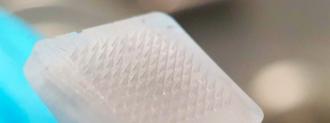City University of Hong Kong (CityU) scientists have created a new microneedle patch to deliver cell therapies — but rather than using traditional materials for their needles, they used ice.
The challenge: Cell therapies use living cells to treat medical conditions. Stem cell transplants are a form of cell therapy, as are some types of cancer immunotherapy.
These cells are typically transplanted into the patient via an implant, injection, or surgical graft. Not only can those delivery methods be painful and invasive, they also carry a risk of infection and must be administered by an experienced professional.
That limits the use of cell therapy to people who are willing to subject themselves to the transplantation process and who also have access to professionals capable of administering them.
Ice, ice baby: Microneedle patches are a growing trend in drug delivery. They’re usually about the size of a postage stamp and are covered in tiny needles made of biodegradable substances packed with drugs.
Press the patch down on the skin like a band aid, and the needles break off from the back of the patch. They then dissolve into the skin, painlessly delivering the drug.
CityU created the microneedles for its patch out of ice, packed with living cells, coated in a protective medium.
Ice is easier to make and work with than the materials traditionally used for dissolving micropatches, but it melts just as readily. Even better, the icy microneedles can preserve the viability of living cells — something other types of patches can’t do.
The freezing cold water: Because the microneedles are made of ice, they would have to be transported and stored frozen, which could be a limiting factor in some places.
Additionally, the icy microneedle patch performed well when used to deliver a cell therapy to mice as a proof of concept, but it still needs to be proven safe and effective in humans.
What’s next: If CityU’s microneedle patch is cleared for use in people, it could have applications even beyond cell therapy.
This device can also package, store, and deliver DNA, vaccines, and more.
Xu Chenjie
“This device can also package, store, and deliver other types of bioactive therapeutic agents, such as proteins, peptides, mRNA, DNA, and vaccines,” lead researcher Xu Chenjie said in a press release.
“I hope this device offers an easy-to-use and effective alternative method for the delivery of therapeutics in clinics.”
We’d love to hear from you! If you have a comment about this article or if you have a tip for a future Freethink story, please email us at [email protected].






